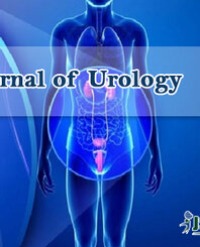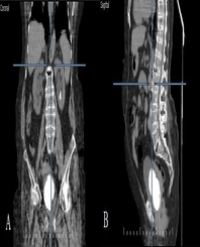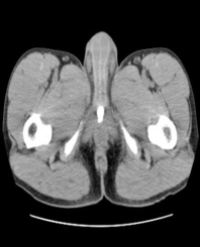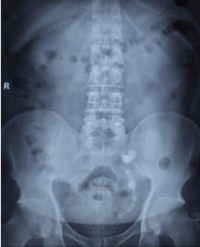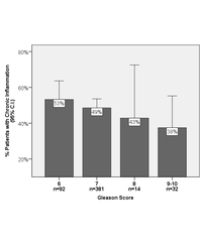
Negative Association of Chronic Inflammation with High-Grade Prostate Tumors Treated by Radical Prostatectomy
Background: Chronic inflammation of the uninvolved prostate has been identified as a potential contributor to the onset and progression of prostate cancer. The goals of this study were to identify the prevalence of chronic inflammation associated with high-grade prostate tumors and to investigate chronic inflammation’s relationship with pathological stage and grade.
Materials and Methods: Consecutive series, retrospective chart review of pathologic data collected from 519 prostate tumors treated by radical prostatectomy. Histological evidence of chronic inflammation was assessed in prostate tissue specimens. Tumor differentiation and aggressiveness was quantified by final Gleason score and final pathologic stage (AJCC TNM staging system) assigned by surgical pathologist. Spearman’s Rho non-parametric correlation was performed to measure the respective relationships of chronic inflammation with Gleason score and with pathologic stage.
Data/Results: Chronic inflammation of the uninvolved prostatic tissue was observed in 255 of the 519 prostatectomy specimens (48.6%). Chronic inflammation was inversely associated with final pathologic stage (T2-T4), corresponding with the following prevalence rate: T2a: 71.4%, T2c: 49.3%, T3a: 42.6%, T3b: 31.4%, T4: 0% (Spearman’s rho = -.167, p < .001). Additionally, chronic inflammation was inversely associated with Gleason scores (GS6- GS10), corresponding with the following prevalence rates: GS6: 54.2%, GS7: 48.4%, GS8: 42.9%, GS9: 38.7, GS10: 0% (Spearman’s rho = -.065, p = .138).
Conclusions: Chronic inflammation in the uninvolved prostate has been identified as a potential mediator of prostate cancer. The study data indicates that chronic inflammation was present in less than 50% of highgrade prostate cancers treated by prostatectomy. An inverse association between the prevalence of chronic inflammation and final pathologic stage was identified. A similar trend towards decreasing Gleason score in prostate cancers associated with chronic inflammation was noted. The study data indicates that poorly differentiated, highly aggressive prostate cancers are less likely to be associated with chronic inflammation.
Timothy Stark1*, Daniel Davenport2 and Stephen Strup1

